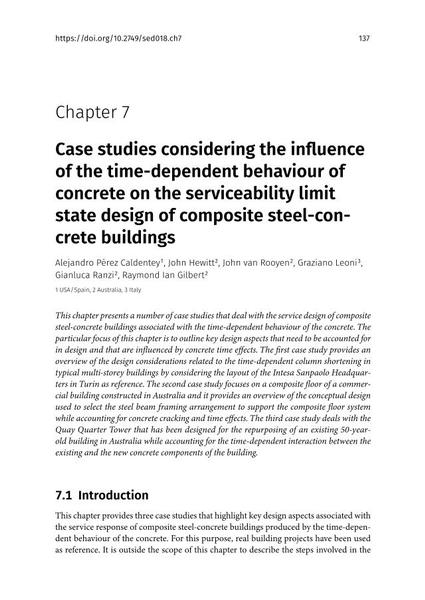Case studies considering the influence of the time-dependent behaviour of concrete on the serviceability limit state design of composite steel-concrete buildings

|
|
|||||||||||
Bibliographic Details
| Author(s): |
Alejandro Pérez Caldentey
John Hewitt (Adjunct Associate Professor, University of Sydney, Australia) John van Rooyen (Associate Director, Taylor Thomson Whitting, Australia) Graziano Leoni Gianluca Ranzi Raymond Ian Gilbert |
||||
|---|---|---|---|---|---|
| Medium: | book chapter | ||||
| Language(s): | English | ||||
| Publisher: | International Association for Bridge and Structural Engineering | ||||
| Published in: | Zurich, Switzerland | ||||
| Published in: | Time-dependent behaviour and design of composite steel-concrete structures | ||||
|
|||||
| Page(s): | 137-156 | ||||
| Total no. of pages: | 20 | ||||
| Year: | 2021 | ||||
| DOI: | 10.2749/sed018.ch7 | ||||
| Abstract: |
This chapter presents a number of case studies that deal with the service design of composite steel-concrete buildings associated with the time-dependent behaviour of the concrete. The particular focus of this chapter is to outline key design aspects that need to be accounted for in design and that are influenced by concrete time effects. The first case study provides an overview of the design considerations related to the time-dependent column shortening in typical multi-storey buildings by considering the layout of the Intesa Sanpaolo Headquarters in Turin as reference. The second case study focuses on a composite floor of a commercial building constructed in Australia and it provides an overview of the conceptual design used to select the steel beam framing arrangement to support the composite floor system while accounting for concrete cracking and time effects. The third case study deals with the Quay Quarter Tower that has been designed for the repurposing of an existing 50-year old building in Australia while accounting for the time-dependent interaction between the existing and the new concrete components of the building. |
||||
| Keywords: |
concrete time-dependent behavior Steel-concrete composite structures
|
||||
| Copyright: | © 2021 International Association for Bridge and Structural Engineering | ||||

